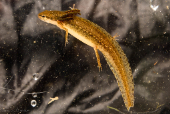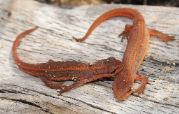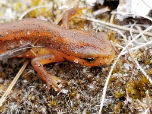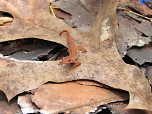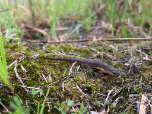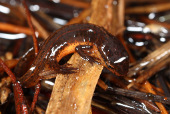|
Striped Newt (Notophthalmus perstriatus)
Description: Growing from 2.12–4.12 inches in length, a fully mature striped newt is yellow-green to olive green to black-brown in color with bright red or orange parallel dorsal stripes. The underside is yellow with black spots. The aquatic larvae are tan, greenish, or brown with bushy external gills and have a distinct light lateral line and dark mottling on the large tail fin. The striped newt can also occur as an eft, which is a terrestrial juvenile stage that spends several years completely on land. Efts can be identified by their light brown or orange coloration and namesake red striping. Neoteny, or paedomorphosis, can be common in populations that live in permanent or semi-permanent fishless ponds. Neotenic adults are yellow-green to brown and often lack the red stripes seen in terrestrial forms.
Habitat: It typically inhabits fire-maintained habitats with sandy soils such as longleaf pine sandhills, scrub, scrubby flatwoods, and occasionally hammock ponds, where it breeds from late winter through spring.
Range: This newt is found from southern Georgia southward into central Florida.
Found in these States:
FL |
GA
Diet: Striped newts are opportunistic feeders. As larvae, they feed on small aquatic invertebrates. As efts, they eat small terrestrial invertebrates. As adults, their diet is influenced by the season. During breeding periods, they usually forage at the bottom of the breeding pond, eating invertebrates such as fairy shrimp, amphibian eggs, and tadpoles. On land, they have been known to eat spiders, small insects, worms, and snails. Observations of their feeding habits have shown that most of their prey range from 6-10 mm in size. Unlike other newt species, striped newts do not normally eat their shed skin.
Reproduction: Nothing is known about the mating systems of striped newts. In a related species (Notophthalmus viridescens), males either capture a female around the neck with their hindlimbs or perform displays until a female becomes receptive to mating. Males usually do not mate with more than two females in one breeding season.
Striped newts become sexually mature at 8 to 24 months of age. Breeding begins in late autumn and can last until early spring. This species breeds in temporary ponds that are free from predators such as fish. Preferred ponds have a tree canopy that provides shade yet allows some sunny areas, and are less than 1.5 m deep. Not much is known about the actual breeding behavior of the species, except that they have a protracted courtship. Eggs are layed one at a time and it can take several months for a female to finish laying all of her eggs. The eggs are adhesive, and are attached to aquatic plants as they are layed. The total number of eggs that may be laid by an individual is not currently known. Except in the case of severe drought, striped newts return to the same pond each year to breed. Because of the unpredictability of their breeding habitats, they may sometimes alter the time that they migrate to breed
Status: Listed as Near Threatened because this species is suspected to be in significant decline (likely in the range of 20–29% over ten years) due to widespread habitat loss through much of its highly fragmented range, thus making the species close to qualifying for Vulnerable.
»» Kingdom: Animalia - Animals
»» Phylum: Chordata - Chordates
»» Subphylum: Vertebrata - Vertebrates
»» Class: Amphibia - (Amphibians)
»» Order: Caudata - Salamanders
»» Family: Salamandridae - Newts
»» Subfamily: Pleurodelinae - Pleurodeline Newts
»» Genus: Notophthalmus
»» Species: Notophthalmus perstriatus - Striped Newt
This article uses material from the Wikipedia article "Striped Newt", which is released under the Creative Commons Attribution-Share-Alike License 3.0. Content may have been omitted from the original, but no content has been changed or extended.
|
|


